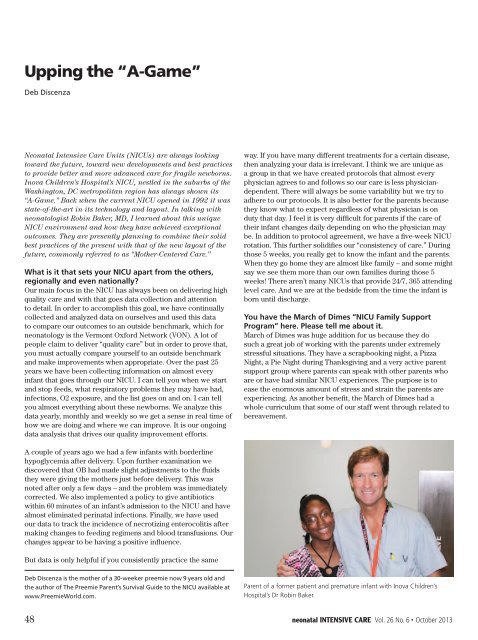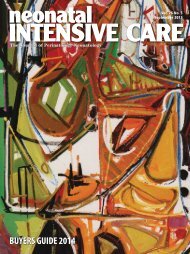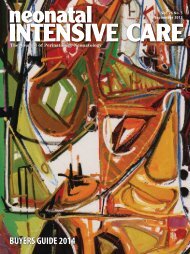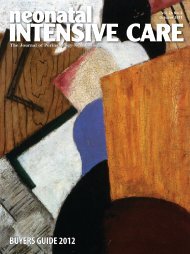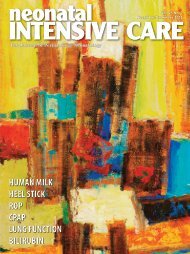Create successful ePaper yourself
Turn your PDF publications into a flip-book with our unique Google optimized e-Paper software.
Upping the “A-Game”Deb DiscenzaNeonatal Intensive Care Units (NICUs) are always lookingtoward the future, toward new developments and best practicesto provide better and more advanced <strong>ca</strong>re for fragile newborns.Inova Children’s Hospital’s NICU, nestled in the suburbs of theWashington, DC metropolitan region has always shown its“A-Game.” Back when the current NICU opened in 1992 it wasstate-of-the-art in its technology and layout. In talking withneonatologist Robin Baker, MD, I learned about this uniqueNICU environment and how they have achieved exceptionaloutcomes. They are presently planning to combine their solidbest practices of the present with that of the new layout of thefuture, commonly referred to as “Mother-Centered Care.”What is it that sets your NICU apart from the others,regionally and even nationally?Our main focus in the NICU has always been on delivering highquality <strong>ca</strong>re and with that goes data collection and attentionto detail. In order to accomplish this goal, we have continuallycollected and analyzed data on ourselves and used this datato compare our outcomes to an outside benchmark, which forneonatology is the Vermont Oxford Network (VON). A lot ofpeople claim to deliver “quality <strong>ca</strong>re” but in order to prove that,you must actually compare yourself to an outside benchmarkand make improvements when appropriate. Over the past 25years we have been collecting information on almost everyinfant that goes through our NICU. I <strong>ca</strong>n tell you when we startand stop feeds, what respiratory problems they may have had,infections, O2 exposure, and the list goes on and on. I <strong>ca</strong>n tellyou almost everything about these newborns. We analyze thisdata yearly, monthly and weekly so we get a sense in real time ofhow we are doing and where we <strong>ca</strong>n improve. It is our ongoingdata analysis that drives our quality improvement efforts.way. If you have many different treatments for a certain disease,then analyzing your data is irrelevant. I think we are unique asa group in that we have created protocols that almost everyphysician agrees to and follows so our <strong>ca</strong>re is less physiciandependent.There will always be some variability but we try toadhere to our protocols. It is also better for the parents be<strong>ca</strong>usethey know what to expect regardless of what physician is onduty that day. I feel it is very difficult for parents if the <strong>ca</strong>re oftheir infant changes daily depending on who the physician maybe. In addition to protocol agreement, we have a five-week NICUrotation. This further solidifies our “consistency of <strong>ca</strong>re.” Duringthose 5 weeks, you really get to know the infant and the parents.When they go home they are almost like family – and some mightsay we see them more than our own families during those 5weeks! There aren’t many NICUs that provide 24/7, 365 attendinglevel <strong>ca</strong>re. And we are at the bedside from the time the infant isborn until discharge.You have the March of Dimes “NICU Family SupportProgram” here. Please tell me about it.March of Dimes was huge addition for us be<strong>ca</strong>use they dosuch a great job of working with the parents under extremelystressful situations. They have a scrapbooking night, a PizzaNight, a Pie Night during Thanksgiving and a very active parentsupport group where parents <strong>ca</strong>n speak with other parents whoare or have had similar NICU experiences. The purpose is toease the enormous amount of stress and strain the parents areexperiencing. As another benefit, the March of Dimes had awhole curriculum that some of our staff went through related tobereavement.A couple of years ago we had a few infants with borderlinehypoglycemia after delivery. Upon further examination wediscovered that OB had made slight adjustments to the fluidsthey were giving the mothers just before delivery. This wasnoted after only a few days – and the problem was immediatelycorrected. We also implemented a policy to give antibioticswithin 60 minutes of an infant’s admission to the NICU and havealmost eliminated perinatal infections. Finally, we have usedour data to track the incidence of necrotizing enterocolitis aftermaking changes to feeding regimens and blood transfusions. Ourchanges appear to be having a positive influence.But data is only helpful if you consistently practice the sameDeb Discenza is the mother of a 30-weeker preemie now 9 years old andthe author of The Preemie Parent’s Survival Guide to the NICU available atwww.PreemieWorld.com.Parent of a former patient and premature infant with Inova Children’sHospital’s Dr Robin Baker.48 neonatal INTENSIVE CARE Vol. 26 No. 6 • <strong>October</strong> <strong>2013</strong>


